jtcrowder49
Plastic
- Joined
- Aug 8, 2022
I hope this is the correct place. It seems to be even after reading the forum/sub rules. Please educate me if not.
I’ll keep the details short for tonight, but I plan to update this post tomorrow when I’m fully alert. There is so much more information!
After finally getting this thing home, I realized it’s one of the uglier machines I’ve seen. Don’t get me wrong, I am beaming with pride over my first mill but I decided it’s appearance needs to change to meet my pride. (At least halfway!)
After a couple hours of YT vids and forum searches I decided it best to skip the “quick paint job” I had in mind and just do the thing right. Seems like it will be easier to paint in parts anyway.
I started tearing into the machine, carefully sorting parts and pieces as I went along. I spent about 7 hours on it so far and the pics below will show you what I have uncovered! Some good, some (I think) less than desirable. Since it’s my first mill, I think it’s still a great purchase. More details to come tomorrow, please feel free to comment on what you see as well. I plan to post updates each day I complete a milestone. Better pics coming too! I just had to get this thing in front of you guys tonight!
Hi all,
You can see my previous post just above this. I'm finally making the long version. Let's get started.
As you guys will be able to see from the photos, I have finally started with the tear down of the machine. I pretty much have it down as far as it can go without a an engine lift or similar. So many feelings about this. Ive been through regret and pride multiple times. Tear down was pretty much uneventful. Everything came apart easy enough so I think I might be the first person to actually get this far into this thing. It is absolutely covered in 30 years worth of shop dust. As you can see from the photos, there are some less than desirable wear items, but honestly, I would have never seen them even if I knew to look there. I wasn't going to disassemble this machine in the old environment. It's mine now, so it is what it is. Nevertheless, I would appreciate honest opinions. It seems to be mostly worn at the saddle. Y axis seems to have more scraping remaining than the X axis. I havent been able to get the underside of the table cleaned yet to look at it.
I did run a dial indicator across the table in both directions before disassembly. End to End along the X axis was about .007 variance across the table. Y was about .004. My main hobby is remote control aircraft so I was pleased with this. I have never been that accurate doing anything in that hobby but I also have never had a tool with this amount of resolution. So, we will see how it goes.
Backlash seems to be about 22 thou on the Y axis and 28 thou on the X axis. I have ordered some replacement nuts for both X and Y. Looking forward to their arrival on Monday along with some other odds and ends that were missing. (Handles and such).
As far as the paint job goes, I stopped in SWP and picked up some paint stripper and a gallon of primer. I will probably go the enamel route since I plan to upgrade to a better machine if I stick with it. I was even able to do a test with the stipper today when I got home. I've attached some pics. Look how this this green layer is between the outer latex layer and the red layer under it. What is this? I thought bondo? The entire machine is this way, which has me thinking against taking a wire wheel to it. (You can see I already tested it)
I've got plans this weekend to take the saddle and smaller pieces outside to power wash them, strip the paint, and apply primer. More pics will come in the next update. I will leave you with a couple questions.
Question from earlier: What is this layer between the paints?
I looked into having the saddle re-scraped, but it appears that the table must also be sent with the saddle. Same with the knee. Is this true? If so, I don't think it's worth my time for such a cheap machine.
I only paid $2500 for it. Year model 1988. As asked, I am located in Alabama.
Attachments
-
 7DEB06FE-F8D8-4DB8-8B09-4210F6E3DC5E.jpeg317.4 KB · Views: 84
7DEB06FE-F8D8-4DB8-8B09-4210F6E3DC5E.jpeg317.4 KB · Views: 84 -
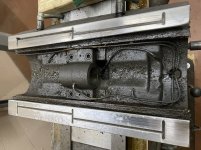 1920F6D5-29F1-4BF1-938E-F77EFCF04098.jpeg422.9 KB · Views: 84
1920F6D5-29F1-4BF1-938E-F77EFCF04098.jpeg422.9 KB · Views: 84 -
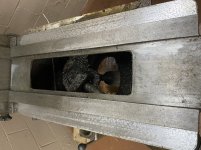 DB79400F-B363-4C26-A209-54B46F9593C8.jpeg393 KB · Views: 85
DB79400F-B363-4C26-A209-54B46F9593C8.jpeg393 KB · Views: 85 -
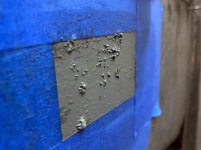 5D77BDA7-F0F6-4056-BE27-18F4F3C210B9.jpeg210.4 KB · Views: 47
5D77BDA7-F0F6-4056-BE27-18F4F3C210B9.jpeg210.4 KB · Views: 47 -
 C8851A12-4A12-485A-AA89-63119D776FC8.jpeg259.2 KB · Views: 46
C8851A12-4A12-485A-AA89-63119D776FC8.jpeg259.2 KB · Views: 46 -
 32A11FC7-0682-4D6A-9098-C2DE57FC6E6E.jpeg239 KB · Views: 47
32A11FC7-0682-4D6A-9098-C2DE57FC6E6E.jpeg239 KB · Views: 47 -
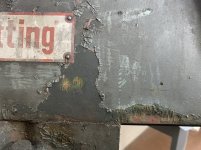 F3D1A690-9480-4C2B-8F9C-A74C952694A7.jpeg411.2 KB · Views: 46
F3D1A690-9480-4C2B-8F9C-A74C952694A7.jpeg411.2 KB · Views: 46 -
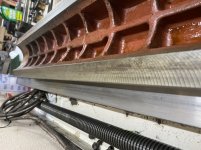 A2B7D6A4-7DAB-435F-8E8D-5C6AE452703E.jpeg325.7 KB · Views: 46
A2B7D6A4-7DAB-435F-8E8D-5C6AE452703E.jpeg325.7 KB · Views: 46 -
 879AAA38-23AE-4BE5-BD60-1A57DD151AA9.jpeg340.7 KB · Views: 46
879AAA38-23AE-4BE5-BD60-1A57DD151AA9.jpeg340.7 KB · Views: 46 -
 A741D141-A358-445C-B585-0638ECB36F3A.jpeg421.8 KB · Views: 47
A741D141-A358-445C-B585-0638ECB36F3A.jpeg421.8 KB · Views: 47
Last edited:



